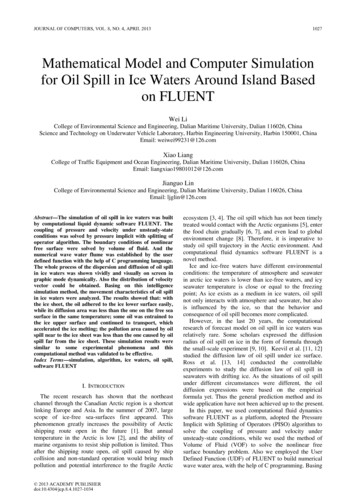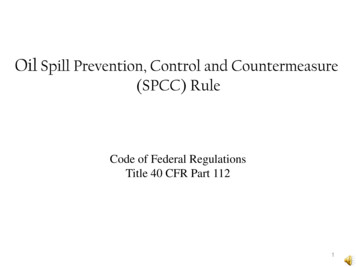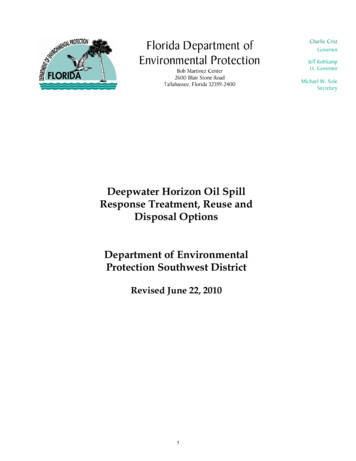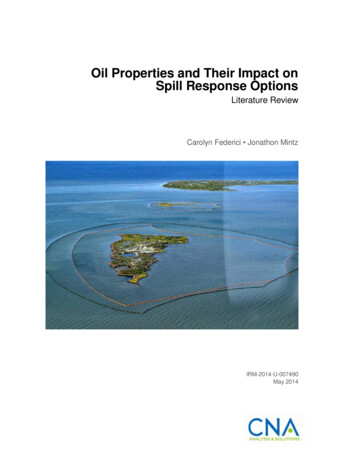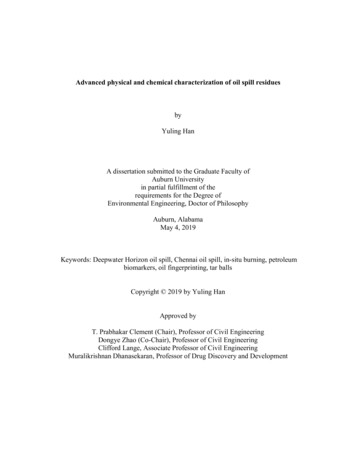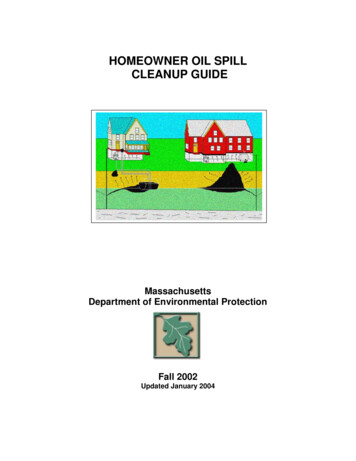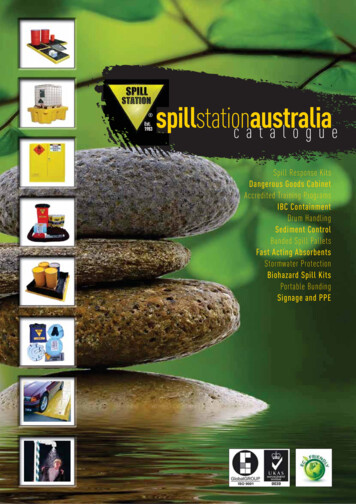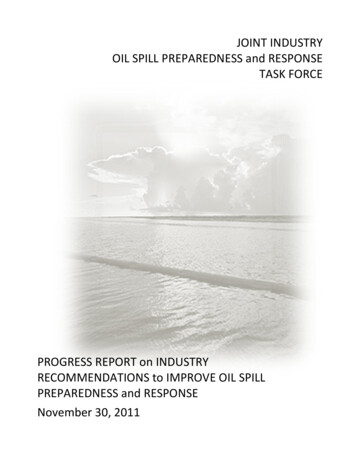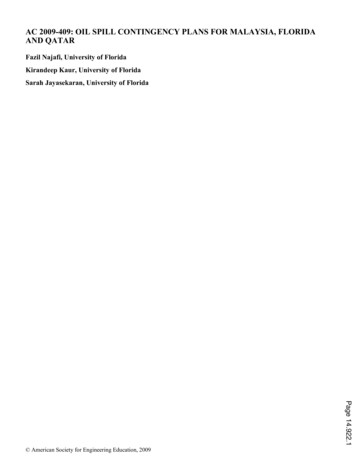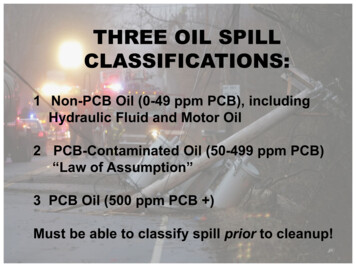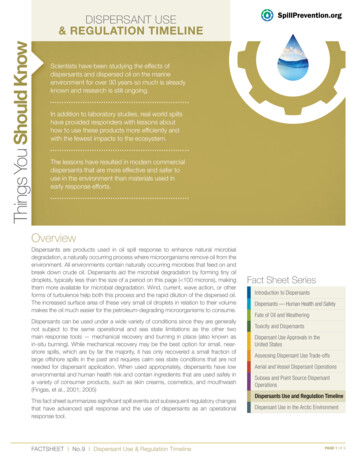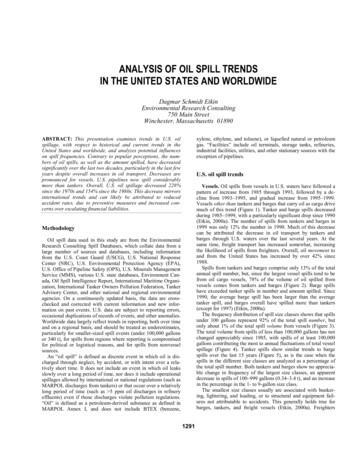
Transcription
ANALYSIS OF OIL SPILL TRENDSIN THE UNITED STATES AND WORLDWIDEDagmar Schmidt EtkinEnvironmental Research Consulting750 Main StreetWinchester, Massachusetts 01890ABSTRACT: This presentation examines trends in U.S. oilspillage, with respect to historical and current trends in theUnited States and worldwide, and analyzes potential influenceson spill frequencies. Contrary to popular perceptions, the numbers of oil spills, as well as the amount spilled, have decreasedsignificantly over the last two decades, particularly in the last fewyears despite overall increases in oil transport. Decreases arepronounced for vessels. U.S. pipelines now spill considerablymore than tankers. Overall, U.S. oil spillage decreased 228%since the 1970s and 154% since the 1980s. This decrease mirrorsinternational trends and can likely be attributed to reducedaccident rates, due to preventive measures and increased concerns over escalating financial liabilities.xylene, ethylene, and toluene), or liquefied natural or petroleumgas. “Facilities” include oil terminals, storage tanks, refineries,industrial facilities, utilities, and other stationary sources with theexception of pipelines.U.S. oil spill trendsVessels. Oil spills from vessels in U.S. waters have followed apattern of increase from 1985 through 1993, followed by a decline from 1993–1995, and gradual increase from 1995–1999.Vessels other than tankers and barges that carry oil as cargo drivemuch of this trend (Figure 1). Tanker and barge spills decreasedduring 1985–1999, with a particularly significant drop since 1990(Etkin, 2000a). The number of spills from tankers and barges in1999 was only 12% the number in 1990. Much of this decreasecan be attributed the decrease in oil transport by tankers andbarges through U.S. waters over the last several years. At thesame time, freight transport has increased somewhat, increasingthe likelihood of spills from freighters. Overall, oil movement toand from the United States has increased by over 42% since1988.Spills from tankers and barges comprise only 13% of the totalannual spill number, but, since the largest vessel spills tend to befrom oil cargo vessels, 78% of the volume of oil spilled fromvessels comes from tankers and barges (Figure 2). Barge spillshave exceeded tanker spills in number and amount spilled. Since1990, the average barge spill has been larger than the averagetanker spill, and barges overall have spilled more than tankers(except for 1997) (Etkin, 2000a).The frequency distribution of spill size classes shows that spillsunder 100 gallons represent 92% of the total spill number, butonly about 1% of the total spill volume from vessels (Figure 3).The total volume from spills of less than 100,000 gallons has notchanged appreciably since 1985, with spills of at least 100,000gallons contributing the most to annual fluctuations of total vesselspillage (Figure 4). Tanker spills show similar trends to bargespills over the last 15 years (Figure 5), as is the case when thespills in the different size classes are analyzed as a percentage ofthe total spill number. Both tankers and barges show no appreciable change in frequency of the largest size classes, an apparentdecrease in spills of 100–999 gallons (0.34–3.4 t), and an increasein the percentage in the 1- to 9-gallon size class.The smallest size classes usually are associated with bunkering, lightering, and loading, or to structural and equipment failures not attributable to accidents. This generally holds true forbarges, tankers, and freight vessels (Etkin, 2000a). FreightersMethodologyOil spill data used in this study are from the EnvironmentalResearch Consulting Spill Databases, which collate data from alarge number of sources and databases, including informationfrom the U.S. Coast Guard (USCG), U.S. National ResponseCenter (NRC), U.S. Environmental Protection Agency (EPA),U.S. Office of Pipeline Safety (OPS), U.S. Minerals ManagementService (MMS), various U.S. state databases, Environment Canada, Oil Spill Intelligence Report, International Maritime Organization, International Tanker Owners Pollution Federation, TankerAdvisory Center, and other national and regional environmentalagencies. On a continuously updated basis, the data are crosschecked and corrected with current information and new information on past events. U.S. data are subject to reporting errors,occasional duplications of records of events, and other anomalies.Worldwide data largely reflect trends in reporting, both over timeand on a regional basis, and should be treated as underestimates,particularly for smaller-sized spill events (under 100,000 gallonsor 340 t), for spills from regions where reporting is compromisedfor political or logistical reasons, and for spills from nonvesselsources.An “oil spill” is defined as discrete event in which oil is discharged through neglect, by accident, or with intent over a relatively short time. It does not include an event in which oil leaksslowly over a long period of time, nor does it include operationalspillages allowed by international or national regulations (such asMARPOL discharges from tankers) or that occur over a relativelylong period of time (such as 5 ppm oil discharges in refineryeffluents) even if those discharges violate pollution regulations.“Oil” is defined as a petroleum-derived substance as defined inMARPOL Annex I, and does not include BTEX (benzene,1291
12922001 INTERNATIONAL OIL SPILL CONFERENCE6,000All Other Vessels5,000Total Barge TankerNumber of 0199119921993199419951996199719981999Figure 1. Annual number of oil spills (1 gallon and over) from vessels in U.S. waters: Barges and tankers versus other vessels(1985–1999) (Environmental Research Consulting Database).1 4 ,0 0 0 ,0 0 01 2 ,0 0 0 ,0 0 01 0 ,0 0 0 ,0 0 08 ,0 0 0 ,0 0 0GallonsB a rg e s a n d T a n k e rsA ll O th e r V e s s e ls6 ,0 0 0 ,0 0 04 ,0 0 0 ,0 0 02 ,0 0 0 ,0 0 001 98 5198 619 8719 8819 891 9901 9911 99 2199 31 99 4199 519 9619 9719 981 999Figure 2. Annual amount of oil spilled by vessels in U.S. waters in spills of 1 gallon and over (1985–1999) (EnvironmentalResearch Consulting Database).1001 0 0 .0909 6 .5Cum . % Num berC u m . % A m t.9 9 .89 8 .99 0 .6807 6 .770% Total60504 8 .5403 3 .530202 5 .28 .4100 .00 .10 .01 .90 .40100000001000000100000100001000100101S p ill S iz e ( G a llo n s )Figure 3. Cumulative percentage of total oil spillage (number of spills and amounts) by size class: U.S. vessel spills (1985–1999) (Environmental Research Consulting Database).1 4 , 0 0 0 ,0 0 01 2 , 0 0 0 ,0 0 01 0 , 0 0 0 ,0 0 08 , 0 0 0 ,0 0 0GallonsS p il ls 1 0 0 , 0 0 0 G a l lo n sS p il ls 1 0 0 , 0 0 0 G a l lo n s6 , 0 0 0 ,0 0 04 , 0 0 0 ,0 0 02 , 0 0 0 ,0 0 199719981999Figure 4. Total amount of oil spilled from vessels into U.S. waters (1985–1999) spill amounts from spills over and under100,000 gallons (Environmental Research Consulting Database).
RESPONSE ISSUES12931801601000000 gal100000 gal10000 gal1000 gal100 gal10 gal1 gal140Number of 9921993199419951996199719981999Figure 5. Annual Number of Tanker Oil Spills In US Waters By Spill Size Class (1985-1999) (Environmental ResearchConsulting Database)tend to have lower overall spill sizes, since the oil originates fromfuel tanks and machinery spaces rather than from cargo holds.Accidents and errors during bunkering, lightering, and loadingcaused 57% of tanker spills, 71% of barge spills, and 53% offreighter spills.The largest vessel spills arise from accidents involving tankers,and occasionally barges, carrying large amounts of oil cargo. Theactual number of tanker accidents (allisions, collisions, andgroundings) has decreased to about 30 per year since reaching apeak of nearly 180 accidents in 1990 (Etkin, 2000a), undoubtedlycontributing to the decrease in tanker spillage. Annually, only0.2% of the more than 41,000 tanker transits result in accidents,and of these accidents less than 2% result in oil spills. The spillrate for tanker accidents has decreased since 1990, likely due toimproved safety regulations and tanker construction. The percentage of tanker accidents resulting in oil spills of 1 gallon ormore decreased sharply since 1990 (Etkin, 2000a).Land-based facility spills. Spills impacting U.S. marine andnavigable waterways and originating from fixed facilities (notpipelines) have decreased dramatically since peaking in 1991(Figure 6), following a pattern similar to vessel spills. The totalamount spilled is dominated by a tiny fraction (0.05%) of the spillnumber that represents spills of 100,000 gallons or more (Figure7). Water-impacting facility spills follow the same frequencydistribution pattern as vessel spills. The smallest spill size classesrepresent a large fraction of the spill number but only a smallfraction of the total spill amount. Spills of over 100 gallons, whilerepresenting only 8.46% of the spill number, make up over 98%of the amount of oil spilled between 1987 and 1999.Spills from U.S. land-based sources (pipelines, storage facilities, fixed industrial facilities, air transport facilities, railways,and motor vehicles) not impacting marine and navigable waterways decreased by 56% in the last 6 years (Figures 8–10) to anaverage of 4,800 spills of one gallon or more annually. These4 ,5 0 04 ,0 0 03 ,5 0 0Number of Spills3 ,0 0 02 ,5 0 02 ,0 0 01 ,5 0 01 ,0 0 996199719971999Figure 6. Annual number of facility spills of 1 gallon and over (excluding pipelines) impacting U.S. waters (1985–1999) (USCGdata with analysis by Environmental Research Consulting).3 ,0 0 0 , 0 0 0S p il ls 1 0 0 ,0 0 0 G a llo n sS p il ls 1 0 0 ,0 0 0 G a llo n s2 ,5 0 0 , 0 0 0Gallons2 ,0 0 0 , 0 0 01 ,5 0 0 , 0 0 01 ,0 0 0 , 0 0 05 0 0 ,0 0 199719971999Figure 7. Annual amount of oil spilled from facilities (excluding pipelines) into U.S. waters (1985–1999) (USCG data withanalysis by Environmental Research Consulting).
12942001 INTERNATIONAL OIL SPILL CONFERENCE8 ,0 0 07 ,5 0 0Number of Spills7 ,0 0 06 ,5 0 06 ,0 0 05 ,5 0 05 ,0 0 04 ,5 0 04 ,0 0 999Figure 8. Total annual number of U.S. land-based oil spills of 1 gallon or more (1987–1999) (EPA data with analysis byEnvironmental Research Consulting).2 5 , 0 0 0 ,0 0 02 0 , 0 0 0 ,0 0 0Gallons1 5 , 0 0 0 ,0 0 01 0 , 0 0 0 ,0 0 05 , 0 0 0 ,0 0 1999Figure 9. Total amount of oil spilled onto land in the United States in spills of 1 gallon or more (1987–1999) (EPA data withanalysis by Environmental Research Consulting).14,000,000AIR TRANSPORT12,000,000HIGHWAYRAILWAYSTORAGE TANK10,000,000PIPELINEGallonsFIXED FACILITY8,000,0006,000,0004,000,0002,000,00001987 19881989 19901991 19921993 19941995 19961997 19981999Figure 10. Annual amount of oil spilled onto land in the United States by source type (1987–1999) (EPA data with analysis byEnvironmental Research Consulting).spills contribute over 9 million gallons of oil to U.S. land andgroundwater resources each year. Fixed and storage facilities, andpipelines, make up the bulk of this spillage. Most of this input isfrom a small number of spills of at least 100,000 gallons (Figure11). Spills of at least 100 gallons represent 47% of spill numberand 99.6% of total spill volume. Spills of 1,000 gallons and overrepresent 16% of spill number and 97% of spill volume.Pipelines. Since 1985, U.S. pipelines have spilled more oilthan tankers and barges combined. Since 1991, pipelines haveannually spilled 37 times as much as tankers. The change in theproportion U.S. pipeline spillage is largely due to the fact thatsince 1990, pipelines transport more oil across more miles thanwater carriers (Figure 12) though the actual pipeline mileage hasnot increased appreciably. U.S. pipelines now carry 69.3% of oiltransported, compared to 30.3% carried by vessels (tankers andbarges). The annual number of pipeline spills has decreased by500% over the last 30 years (Figure 13). Spill amounts are dominated by a small number of large events. Over 74% of pipelinespills involve 100 gallons or less, while spills in these smallersize classes contribute only 0.8% of the total amount spilled. 90%of spills are under 1,000 gallons. Overall, the amount spilled hasdecreased (Figure 14).
RESPONSE ISSUES12953 0 ,0 0 0 ,0 0 02 5 ,0 0 0 ,0 0 02 0 ,0 0 0 ,0 0 0S p ills 1 0 0 ,0 0 0 G a llo n sGallonsS p ills 1 0 0 ,0 0 0 G a llo n s1 5 ,0 0 0 ,0 0 01 0 ,0 0 0 ,0 0 05 ,0 0 0 ,0 0 1999Figure 11. Total annual oil spillage onto land in the United States: Spills over and under 100,000 gallons (EPA data withanalysis by Environmental Research Consulting).700Billion Ton-Miles600500400300Pipelines200W ater 9750Figure 12. U.S. oil transport by pipelines and water carriers (1975–1999) (Bureau of Transportation Statistics data withanalysis by Environmental Research Consulting).600500Number of 198219801978197619741972197019680Figure 13. Number of oil transport pipeline spills in United States (1968–1999) (Environmental Research ConsultingDatabase).70 ,0 00,00 060 ,0 00,00 050 ,0 00,00 0Gallons40 ,0 00,00 030 ,0 00,00 020 ,0 00,00 010 ,0 00,00 519741973197219711970196919680Figure 14. Amount of oil spilled from U.S. oil transport pipelines (1968–1999) (Environmental Research Consulting Database).
12962001 INTERNATIONAL OIL SPILL CONFERENCEStructural failures are the most common cause of U.S. pipelinespills, representing 40% of spills. 75% of structural failure isattributed to corrosion, 15% to defective pipes, and 10% to defective welds. With an aging pipeline infrastructure in the UnitedStates—46% of pipelines are over 30 years old, 16% are over 50years old, and over 2% are over 70 years old—more spills causedby structural failure may be expected in the future. “Outside forcedamage”—ramming by bulldozers or other equipment or naturaldamage from floods or earthquakes—cause 27% of spills.Offshore spills. While 98% of U.S. pipeline spills occur ontoland, occasional spills (less than 10 per year) from nearshore andoffshore pipelines contribute to marine oil input (Figure 15).Spills from Outer Continental Shelf (OCS) exploration and production (E&P) facilities have also decreased significantly sinceU.S. offshore E&P activities began (Figure 16). Nearly 94% arespills of less than 50 barrels (2,100 gallons). On average, 80% ofOSC spills are from platforms as opposed to OCS pipelines (Figure 17). Total OCS spillage has averaged 200,000 gallons peryear, much of this is due to a small number of very large spills(Figure 18).Overall 1990s oil spillage in the United States. Overall U.S.spill amounts for 1990–1999 are shown in Figure 19. The totalamount spilled in the 1990s was 134 million gallons, a significantdecrease from the previous two decades where 305 million gallons and 206 million gallons of oil spilled (Figure 20). Most ofthe oil spilled in the 1990s came from fixed facilities and landpipelines. Vessels contributed only 15%. OCS E&P facilitiescontributed only 1.4% of the total oil spillage.Worldwide oil spill trendsReductions in U.S. oil spillage largely mirror internationaltrends (Figures 21–22). Spill numbers and amounts have decreased since 1990, though very large spills can skew oilamounts. The decrease is encouraging in light of a 46% increasein oil movement worldwide since 1988. Data presented (Figure23–25) are underestimates for both numbers and amounts, sincedata collected on an international basis are subject to serious reporting errors and omissions, particularly for spills from particular regions, for smaller spills, and for spills from non-vesselsources. For example, vessel spills receiving media coveragebecause of their high-profile location or particular circumstancesare more likely to be reflected than smaller pipeline spills in remote areas.Assuming spills internationally follow similar patterns of spillsize frequency distributions to U.S. spills, spills of at least 10,000gallons represent 90% of the amount spilled, but only 5% of theactual numbers of spills. This logic was applied in analyzing thedata shown in Figure 26. International estimates for the amountspilled and spill number in marine waters were derived by estimating the number of spills under 10,000 gallons and theamounts spilled in those size classes based on size class frequency distributions for more well-documented U.S. spill datasets (based on the methodology in Etkin, 1998a, 1999).8 0 0 ,0 0 07 0 0 ,0 0 06 0 0 ,0 0 0Gallons5 0 0 ,0 0 04 0 0 ,0 0 03 0 0 ,0 0 02 0 0 ,0 0 01 0 0 ,0 0 19981999Figure 15. Annual amount of oil spilled into U.S. waters by marine pipelines (1986–1999) (Office of Pipeline Safety data withanalysis by Environmental Research Consulting).300250Number of Spills200TO TALT O T A L 1 -5 0 b b l)T O T A L ( 5 0 b b l )150100-0 .7 0y 3 2 7 .8 0 x2R 0 .8 71975197319710Figure 16. Annual number of oil spills from U.S. OCS exploration and production facilities (1971–1999) (MMS data withanalysis by Environmental Research Consulting).
RESPONSE ISSUES12972 50Number of Spills2 00P latfo rmP ipe lin e1 501 197197197197130Figure 17. Annual number of U.S. OCS platform and pipeline spills (1971–1999) (MMS data with analysis by EnvironmentalResearch Consulting).1 , 0 0 0 ,0 0 0Gallons8 0 0 ,0 0 06 0 0 ,0 0 04 0 0 ,0 0 02 0 0 ,0 0 519741973197219710Figure 18. Total annual spillage from U.S. OCS facilities (1971–1999) (MMS data with analysis by Environmental ResearchConsulting).Marine Pipelines1.0%OCS E&P1.4%Marine Facilities6.2%Tankers5.0%Barges5.9%Other Vessels4.2%Land Pipelines22.4%Storage Tanks10.0%Air Transport Facilities0.4%Unknown LandFacilities7.3%Fixed Land Facilities30.3%Railroad2.2%Highway3.7%Figure 19. Sources of U.S. oil spillage (amount spilled from 1990–1999) (Environmental Research Consulting Database).1 4 0 ,0 0 0 ,0 0 0T a n k e rsP ip e lin e sF a c ilitie sB a rg e sE&PN o n -T a n k V e s s e lsO th e r1 2 0 ,0 0 0 ,0 0 0Gallons1 0 0 ,0 0 0 ,0 0 08 0 ,0 0 0 ,0 0 06 0 ,0 0 0 ,0 0 04 0 ,0 0 0 ,0 0 02 0 ,0 0 0 ,0 0 001960s1970s1980sFigure 20. Estimated annual amount of oil spilled in the United States by source (Environmental Research ConsultingDatabase).
12982001 INTERNATIONAL OIL SPILL CONFERENCE450400350Number of 61982198419781980197619741972197019680Figure 21. Annual number of oil spills of 10,000 gallons (34 tons) or more worldwide (1968–1999) (Environmental ResearchConsulting Database).4 5 0 , 0 0 0 ,0 0 04 0 0 , 0 0 0 ,0 0 03 5 0 , 0 0 0 ,0 0 0Gallons3 0 0 , 0 0 0 ,0 0 02 5 0 , 0 0 0 ,0 0 02 0 0 , 0 0 0 ,0 0 01 5 0 , 0 0 0 ,0 0 01 0 0 , 0 0 0 ,0 0 05 0 , 0 0 0 ,0 0 2707419191919680Figure 22. Annual amount of oil spilled worldwide (1968–1999) (Environmental Research Consulting Database).E&P1 2 .8 %F a c ilitie s7 .9 %U n k n o w n /O th e r0 .1 %P ip e lin e s4 .2 %N o n -T a n k V e s s e ls0 .2 %T a n k e rs7 4 .2 %B a rg e s0 .6 %Figure 23. Estimated total amount of oil spilled into marine waters worldwide (1970–1979). Total amount spilled:1,465,500,000 gallons (4,985,000 tons) (Environmental Research Consulting ges0.8%Facilities34.2%Pipelines18.2%Non-Tank Vessels1.4%Figure 24. Estimated total amount of oil spilled into marine waters worldwide (1980–1989). Total amount spilled: 844,970,000gallons (2,874,000 tons) (Environmental Research Consulting Database).
RESPONSE Tankers57.2%Pipelines6.4%Non-Tank Vessels1.7%Barges0.3%Figure 25. Estimated total amount of oil spilled into marine waters worldwide (1990–1999). Total amount spilled: 943,170,000gallons (3,208,000 tons) (Environmental Research Consulting Database).1000900800Million Gallons7001 9 7 0 -1 9 7 96001 9 8 0 -1 9 8 91 9 9 0 -1 9 9 95004003002001000T a n k e rsB arg esN o n -T a n kV e s s e lsP i p e li n e sF a c i li t i e sE&PFigure 26. Estimated total oil spill amounts by source type (Environmental Research Consulting Database).Worldwide, tanker spills dominated the oil spill picture untilthe 1990s when large pipeline and facility spills occurred. Thepercentage of oil contributed by tanker spills has decreased from74% in the 1970s to 34% in the 1990s. Extremely large spills,such as the 1991 Gulf War spills and the 1979 Ixtoc I well blowout, and large tanker spills in the 1970s, dominate spill amounts.DiscussionContrary to popular perceptions after recent catastrophicevents, oil spill frequencies and total spillage have decreasedsignificantly over the 20 years, particularly in the last few years,despite overall increases in oil movement. The decrease in oilspills worldwide, but in the United States in particular, may beattributed to a variety of influences. The impacts and repercussions of the 1989 Exxon Valdez spill, largely the impetus for passage of the Oil Pollution of 1990 (OPA 90), were watchedworldwide. With OPA 90, the United States has the strictesttanker regulations. Improved safety standards, contingency planning, exercise programs, and other measures have helped reduceU.S. spillage. International conventions and national legislationhave reduced worldwide oil spillage.Much of this reduction, however, was realized before the implementation of OPA 90 and other regulations and conventions.Another important influence on spillage rates has been realizationby tankers owners and other potential spillers that spills in theUnited States could result in astronomical costs for which thespiller could have unlimited liability (a result of OPA 90).Cleanup, penalty, and damage costs associated with the ExxonValdez spill and other significant events in its aftermath haveseriously raised the stakes for potential oil spillers. Cleanup costshave risen dramatically in the last two decades even when corrected to current values (Etkin, 1998b, c). Implementation ofpending increases in environmental damage liability nationally oras part of international liability and compensation conventions,along with increases in oil spill damage liability and penalties(Etkin, 2000b) for all spill sources, could change the oil spillpicture on a worldwide basis.While the statistics show encouraging downward trends, thereis no room for complacency. An ill-timed oil spill that occurs in asensitive location, regardless of spill size, can cause devastatingdamage to natural environments, property, and business, and,occasionally, to human lives. Aging pipeline and facility infrastructures, as well as aging vessel fleets, may be “ticking timebombs” especially as they become subjected to increasing oilthroughput and transport in future years. Increased internationalattention to tanker safety has had a positive influence that issorely needed in other vessel categories and for nonvesselsources, particularly pipelines.BiographyDagmar Schmidt Etkin received A.M. and Ph.D. degrees fromHarvard University. Her environmental science experience includes: 12 years investigating population biology and ecology,and 11 years specializing in oil/chemical spill database development, data analysis, risk assessment, and cost analyses, most recently in her own independent consulting firm, EnvironmentalResearch Consulting.
13002001 INTERNATIONAL OIL SPILL CONFERENCEReferences1.2.3.Etkin, D.S. 1998a. Factors in the Dispersant Use Decision-Making Process: Historical Overview and Lookto the Future. Proceedings, Twenty-First Arctic and Marine Oilspill Program (AMOP) Technical Seminar. Environment Canada, Ottawa, Ontario. pp. 281–304.Etkin, D.S. 1998b. Financial Costs of Oil Spills in theUnited States. Cutter Information Corp., Arlington, MA.Etkin, D.S. 1998c. Oil Input Into the Marine Environment: Accidental Releases From Vessels, Pipelines, Exploration & Production Activities, Facilities, and Un-4.5.6.known Sources. Report to Joint Group of Experts on theScientific Aspects of Marine Protection (GESAMP)Working Group 32: Oil Input Into the Marine Environment, November 1998.Etkin, D.S. 1999. Marine Oil Spills Worldwide: AllSources. Cutter Information Corp., Arlington, MA.Etkin, D.S. 2000a. A Worldwide Review of Oil Spill Finesand Penalties. Environmental Research Consulting, Winchester, MA.Etkin, D.S. 2000b. US Vessel Spills 1985–1999: AStatistical Review. Environmental Research Consulting,Winchester, MA.
Environmental Research Consulting 750 Main Street Winchester, Massachusetts 01890 . fiOilfl is defined as a petroleum-derived substance as defined in MARPOL Annex I, and does not include BTEX (benzene, . 1294 2001 INTERNATIONAL OIL SPILL CONFERENCE 4,000 4,500 5,000 5,500 6,000 6,500 7,000 7,500
